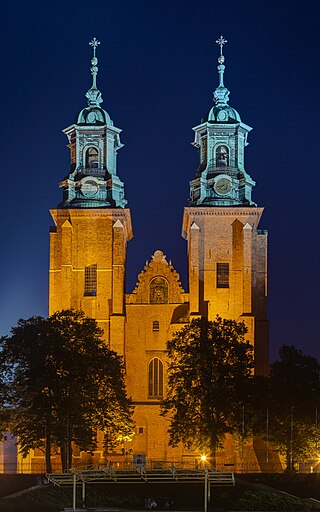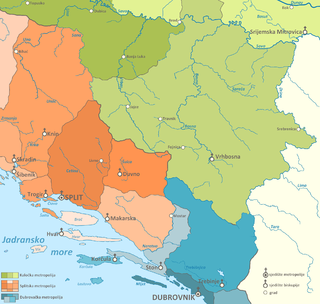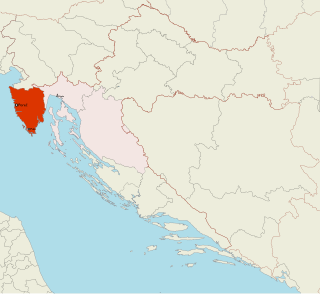
The Archdiocese of Gniezno is the oldest Latin Catholic archdiocese in Poland, located in the city of Gniezno. The ecclesiastical province comprises the suffragan dioceses of Bydgoszcz and Włocławek.

Tragurium, Ancient Latin name of a city in Dalmatia, now called Trogir, was a bishopric until 1829 and a Latin titular bishopric until 1933.

The Diocese of Kotor is a Latin Church ecclesiastical jurisdiction or diocese of the Catholic Church in the Bay of Kotor and Municipality of Budva area in Montenegro. It is centered in the city of Kotor (Cattaro). It was erected as a diocese in the 10th century. The current bishop is Mladen Vukšić.

The Catholic Church in Sierra Leone is part of the worldwide Catholic Church, under the spiritual leadership of the Pope in Rome.

The Archdiocese of Split-Makarska is a Latin Metropolitan archdiocese of the Catholic Church in Croatia and Montenegro. The diocese was established in the 3rd century AD and was made an archdiocese and metropolitan see in the 10th century. The modern diocese was erected in 1828, when the historical archdiocese of Salona was combined with the Diocese of Makarska. It was elevated as an archdiocese and metropolitan see in 1969, restoring the earlier status of the archdiocese of Split, as it is also known. The diocese was also known as Spalato-Macarsca.

The Archdiocese of Matera-Irsina is a Latin archdiocese of the Catholic Church in Basilicata, Italy. It has existed under this name since 1986. The archbishop is seated at Matera Cathedral.. It is a suffragan of the Archdiocese of Potenza-Muro Lucano-Marsico Nuovo.

The Roman Catholic Diocese of Poreč and Pula is a suffragan Latin diocese in the ecclesiastical province of the Metropolitan Archdiocese of Rijeka on Istria peninsula, in Croatia.

The Pula Cathedral or fully the Cathedral of the Assumption of the Blessed Virgin Mary is a co-cathedral in Pula, Croatia. Along with the Euphrasian Basilica it is one of the two official seats of the Roman Catholic Diocese of Poreč and Pula. The church is located on the south side of the Pula bay at the foot of the hill with the 17th century Venetian fort. The site of the present-day church has been used for religious worship since ancient Roman times and the first Christian churches on the site were built in the late 4th and early 5th century AD. These had gone through a series of enlargements and reconstructions over the ages.

Dražen Kutleša is a Croatian prelate of the Catholic Church who became Archbishop of Zagreb in April 2023 after two months as archbishop coadjutor. He was the archbishop of Split-Makarska from 2022 to 2023 after serving as bishop of Poreč and Pula from 2012 to 2020.

The Diocese of Duvno was a Latin rite particular church of the Catholic Church that was established in the 14th century with a seat in present-day Tomislavgrad in Bosnia and Herzegovina. It was a suffragan diocese of the Archdiocese of Split, and during the 17th century of the Archdiocese of Dubrovnik. The diocese consisted of four parishes: Roško Polje, Duvno, Posušje and Rama.
The Diocese of Pula was a Roman Catholic diocese in Croatia, located in the city of Pula. In 1828, it was suppressed and united with the Diocese of Poreč to form the Archdiocese of Diocese of Poreč-Pula.

Co-cathedral of St. Mark the Evangelist is a baroque church and former cathedral in the Archdiocese of Split-Makarska. It is located in the center of the town of Makarska, Croatia, on Andrija Kačić Miošić Square.

Frane Franić was a prelate of the Catholic Church who served as the Archbishop of Split-Makarska from 1969 until his retirement in 1988. He also served as the last Bishop of Split-Makarska, before the diocese was elevated to the status of an archdiocese, from 1960 to 1969.
The Diocese of Arbe or Diocese of Rab or Diocese of Arba was a Roman Catholic diocese located in the town of Arbe on the Croatian island of the same name located just off the Adriatic coast of northern Dalmatia, in Croatia, where still stands the former cathedral, dedicated to the Assumption of Mary.
The Diocese of Makarska was a Latin Catholic bishopric from 533 to 590, from 1344 to 1400 and from 1615 until its 1828 merger into the Diocese of Split-Makarska, which preserves its title.

Ranko Vidović is a Croatian prelate of the Catholic Church who currently serves as the bishop of Hvar-Brač-Vis since 2021.
Madius was a prelate of the Catholic Church who served as the bishop of Duvno from between 1298 and 1311 to his resignation in 1344. Konrad Eubel considers him a second bishop of Duvno, while Dominik Mandić left the question open whether Madius was indeed the second or the first bishop of Duvno, as he couldn't find any document confirming his alleged predecessor John of Hoio as the bishop of Duvno. During his episcopate, he was involved in long-lasting litigations against the archbishops of Split as a representative of Bishop Valentin of Makarska over the control of Omiš and other church objects. Madius resigned due to what he calls "maliciousness of the people", which might refer to the opposition of his faithful to pay taxes and the political plight which befell him after his patrons from the Šubić family lost the political influence after the conquest of their domains by Stephen II, Ban of Bosnia. He nevertheless retained the title of a bishop and, according to Ante Škegro, lived on the territory of the Archdiocese of Split.